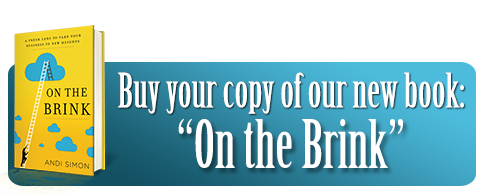Over the past several years, I have blogged about my experiences at the HubSpot Inbound Marketing conference. So, it is time to do so again.
Setting the stage
But wait a minute. Let me set the stage before I talk about Inbound 2016. Simon Associates Management Consultants (SAMC) has built a business around helping organizations change. As corporate anthropologists, a big part of our work is teaching business leaders how to use their own eyes to see, feel and think in different ways about their companies.
Intentionally, our business is eclectic. We have clients in healthcare, higher education and those that are tough to put into a box, such as cement companies, professional organizations and non-profits. Why do all these different companies hire us? Because of our process. As Blue Ocean Strategists®, we help clients forget about the competition and instead, focus on how they can meet their customers’ unfulfilled needs, thus creating new markets.
With that as a backdrop, I’ll now talk a little about the conference, Inbound 2016, within the context of what we do at Simon Associates. It was a well-attended conference (18,000 people) and offered many subject areas across multiple content sessions. But what I would like to focus on here is the keynote speech given by Brian Halligan, HubSpot Co-founder and CEO.
Not the only Corporate Anthropologist in the house
So, what did Brian talk about in the first three minutes of his keynote? He told the story of founding HubSpot ten years ago by focusing on the end user…the customer. He studied how humans shopped. And it was that study that propelled him to develop the Inbound methodology. Then, in a standing-room-only crowd of thousands of attendees, he said that one of his heroes is Sir David Attenborough, a social anthropologist.
Well, whether you call someone a social anthropologist or a corporate anthropologist, they essentially are within the same discipline and do the same things. At Simon Associates, we are corporate anthropologists using the methodology described by the keynote speaker. This informs the way we think, the way we observe human behavior, and the way we discern what this behavior means. You see, taking a bunch of surveys is nice but if you really want to see how people behave, forget the surveys. Go out and do observational research! (Perhaps the folks in Hillary’s camp spent too much time conducting surveys rather than listening and observing. For more on this, read the article written by Dr. Andi Simon for The Huffington Post.)
We have been doing what the HubSpot founder did for just about as long
Andi Simon (my wife, founder of Simon Associates and author of The Huff Post article mentioned above), has recently written a book which reinforces what Mr. Halligan was talking about. In her book, “On the Brink: A Fresh Lens to Take Your Business to New Heights,” she takes the mystery out of corporate anthropology and gives examples of why this field of study helps companies identify changing times and reposition themselves for the future. It is seeing the world through a fresh set of eyes that allows one to make the necessary changes and set the stage for exponential growth.
Similarly, in Brian Halligan’s keynote he talked about conducting observational research. In the same vein but taking it further, Andi has developed an anthropological tool kit which allows businesspeople to actually “do” what Mr. Halligan touched on in his talk. Specifically, here are some of the things you can go out into the field and practice to become your own corporate anthropologist!
- Get out of your office. Conduct observational research.
- Find customer pain points. Listen to your customer.
- Use or listen to storytelling. This is much more effective than just stating facts.
- Follow your customers for a day. What they say and what they do are often very different.
- Evaluate your company culture. Should it be changed?
So, getting back to Inbound 2016. I suspect that Brian Halligan built his organization by understanding and carrying out the points listed above. It is this deep understanding of customer behavior and customer need that has enabled HubSpot to develop a platform that provides ease and elegance in managing the Inbound or digital process.
So, what else did I learn?
One thing I learned was that there are some very interesting trends out there in the world of Inbound. Here are Brian Halligan’s major points with my comments:
- Text to video. For those of you who don’t like to write, the trend is moving from written text blogs to videos — very important. And if you believe the figures, you probably won’t need to read or write shortly!
- Live in social media. If you think about social media as just an afterthought, think again. It needs to be a very important element in your marketing mix. At SAMC last year, we conducted a study regarding the use of social media. For one client, effective use of it doubled their monthly site visits.
- Accelerate content. The entire way your customer make purchase decisions has changed. Providing content and then more content allows the customer to make informed purchase decisions along the way and moves them towards the ultimate purchase decision.
- Automate buying. While this is a plug to use HubSpot, it does allow you to move people along the purchase cycle the way THEY want to be lead and creates an easier more elegant process.
At SAMC, we understand the power of the Inbound process
Using our anthropological tool kit to understand customer need and then respond to it can make a significant difference in identifying success. This is what allows us at SAMC to design strategic positioning for our clients that is unique and preemptive, and that capitalizes on the full range of inbound marketing tools. If you would like to know more about corporate or social anthropology and how to fuse them together into an effective Inbound marketing program, please contact us.
Want to know more about Inbound Marketing? Read our White Paper.
To run a business effectively, you want to attract the people who want the solutions you are offering. In today’s digital age, consumers no longer wait for marketers to push out information the old-fashioned way about their services (outbound marketing). They now search online for answers to their questions and solutions to their problems (inbound marketing). Inbound Marketing is the best way to turn “searchers” into customers and then promoters of your business. Our white paper explains it all.
Andy Simon, Partner
Simon Associates Management Consultants





